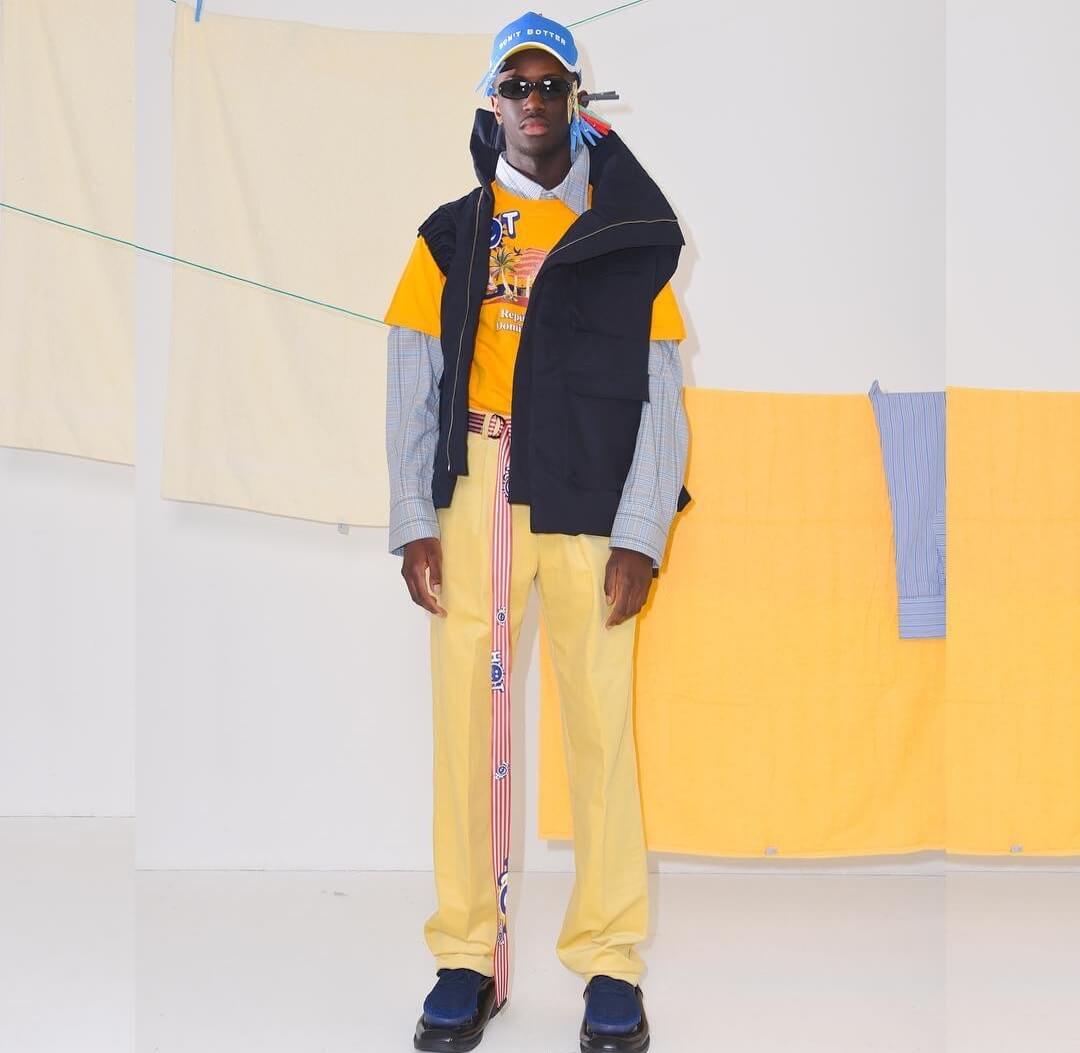Shake it up
We explore Dutch menswear design duo Rushemy Botter and Lisi Herrebrugh’s avant-garde label BOTTER and their new appointment as creative directors for storied French fashion house Nina Ricci.

Nothing spoils the pleasure of fashion like an over-cerebral meditation on seriousness. Indeed, it is meant to be an antidote to seriousness—a kind of wearable escapism. We use fashion to convince others and ourselves that we are the sort of people we always wanted to be, living our very best lives. It takes a special and extremely rare sort of talent to inject hard reality into the frivolous bubble of fashion without popping it.
Enter the Dutch duo of Rushemy Botter and Lisi Herrebrugh and their avant-garde label BOTTER.
Mr Botter and Ms Herrebrugh were crowned winners of this year’s Hyères festival—a French prestige pow-wow at a fabulous modernist villa on the Riviera at which emerging talents are selected and elevated by a panel of taste-making elites, in this case Tilda Swinton, Farida Khelfa, Haider Ackermann, Delfina Delettrez Fendi and Lou Doillon.
The collection they presented was a virtuoso blend of tailoring and trash; street-style glamour with a dark backstory of ecological collapse and tragedy at sea. Beautifully patterned fabrics were used to create fresh takes on suiting, dressed down with mordant, statement sweatshirts and stacks of American ball caps, the whole thing styled with the sort of plastic flotsam that drifts and bobs in nation-sized patches of ocean. The narrative subtext was drawn from the inescapable darkness streaming into every European home for the last three years: bleaching coral reefs, trash-choked oceans full of expanding dead-zones—empty but for an unending drizzle of human litter—child refugees fished from the ocean, often dead or dying. Shawls resembling fishermen’s netting draped the models’ necks making them resemble sea-turtles caught in drifting nets or six-pack rings. One wore an ascot made of the sort of disposable grocery bag that’s been made illegal in much of Europe and coastal America. A particularly grim touch was the little plastic safety floatie attached to one of the model’s wrists.
And at the same time the message was one of optimism: here were men of colour (all of the models were black) emerging triumphantly from a turbulent and polluted seascape. Their bodies were draped in the detritus left behind by the ravaging organs of predatory colonial extraction and racial stereotyping (Shell and Kool-Aid both get a much-deserved savaging in BOTTER’s take on black history). Ms Herrebrugh and Mr Botter have described their fascination for the way that people in developing countries are forced by adversity into extremes of creativity and their collections are a homage to the ingenuity and resilience of the so-called third world. And the whole thing is pulled off without the slightest bit of finger-wagging sanctimony. The collections feel light and spontaneous and one feels that their pessimistic subtext would probably fly right over the head of fashion’s less intellectually gifted patrons.
Botter and Herrebrugh both have ancestral ties to the Caribbean (respectively: Curacao and the Dominican Republic) and their label’s DNA is a double helix composed of two strands: 1.) style from the developing world, and, 2.) European tradition and technique.
Botter, who spent most of his life in Amsterdam, is a graduate of Antwerp’s Royal Academy of Fine Arts where he was mentored by Walter Van Beirendonck and, in his master year, by Dirk Van Saene. In his second year at the Academy he won the Most Promising Student Prize and was, in short order, invited to present a collection during New York Fashion Week upon being awarded the VFiles Runway 7 prize under the aegis of Jerry Lorenzo, Naomi Campbell and the rapper Young Thug.
Herrebrugh was born in Amsterdam to a Dominican mother and a Dutch father and raised in a bilingual home. She’s a graduate of the Amsterdam Fashion Institute, where she graduated cum laude, before moving on to assist Viktor & Rolf with their triumphant return to Paris couture after a 13-year hiatus.
BOTTER’s poignant and sophisticated uniqueness is the product of a very personal approach to creation which is filtered through family and memory. The duo has spoken about how their breakthrough collection (named Al Fombra) was inspired, in part, by the lotto shacks one finds throughout the Dominican Republic and Curacao. People go into the shacks in the hopes that their aspirational dreams will one day be realized in a flash of good fortune, although at the same time, deep down, they know that most of the shacks are corrupt endeavours that will never pay out. The entire collection was infused with a feeling of ambivalent pessimism.
Botter and Herrebrugh, who graduated in 2014, were named artistic directors of the fabled French house Nina Ricci in August of 2018, much to the surprise of the Paris fashion universe, in which designers are usually removed and replaced from a fixed pool of candidates, and outsiders generally spend years toiling anonymously in design teams before earning their boldface bona fides.
Nina Ricci is owned by the Spanish multinational Puig, whose president of brands, markets and operations, José Manuel Albesa told WWD, “We were looking for someone unique. They did some sketches to show their vision for the brand, and I was really amazed because it was not an evolution, it was a revolution.”
The design duo moved from Antwerp to Paris this September bringing with them BOTTER and their unique aesthetic: one that has the potential to channel some much-needed diversity into the closed and self-referential sphere of Paris menswear—an elite little world that takes inspiration from and caters to, mostly, white men. We can’t wait to see them shake it up.